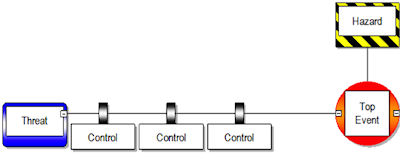Definition
Any measure taken which acts against some undesirable force or intention, in order to maintain a desired state.
Additional Guidance (relevant to Prevention and Recovery Controls):
Usually there will already be numerous ways in which you seek to prevent the top event from occurring.
The addition of these controls to the bowtie is the next step. The controls would look at two aspects of threat management:
eliminating the threat completely, therefore making sure the threat is not present and
preventing the threat from developing into a top event if the threat does become “live”.
In the example of driving a car on a busy motorway, to eliminate our threat of a tyre blow out, the car owner would conduct regular tyre inspections to identify any potential issues which might lead to a tyre blow out. If our threat becomes “live” and a tyre blow out occurs, our preventative control could be driver steering into the skid to keep control.

Traps and tips
- Trap: Control descriptions that are too generic or vague e.g. control: ‘ATC’.
- Tip: Describe what the control actually does with the reader in mind e.g.: ‘ATC detect incorrect presence on the runway and issue avoiding instructions’. Try to include the action that takes place to interrupt the sequence of events.
- Trap: Incorrect level of detail for diagram elements.
- Tip: When deciding the level of detail to include for the description of any diagram element there are several important considerations:
- Too little detail - The diagram might be referred to by people separated by time and location from the author (e.g. bowties are often used as a standalone poster). Enough detail should be included in the element descriptions to support the reader's understanding of the author’s intention without reference to additional explanatory or supporting material.
- Too much detail - The opposing consideration for an appropriate level of detail is that the descriptions should not be overly convoluted or lengthy. Diagram elements may be considered as risk exclamation marks and by remaining concise, their communication benefits are maximised. Generally, one sentence should suffice.
- Tip: When deciding the level of detail to include for the description of any diagram element there are several important considerations:
- Trap: Not including poor quality controls.
- Tip: Include controls that are generally considered to be in place even if they have very poor effectiveness. Using colours to illustrate control effectiveness will highlight these areas for potential improvement.
See Recovery controls for more additional guidance relevant to prevention controls.

